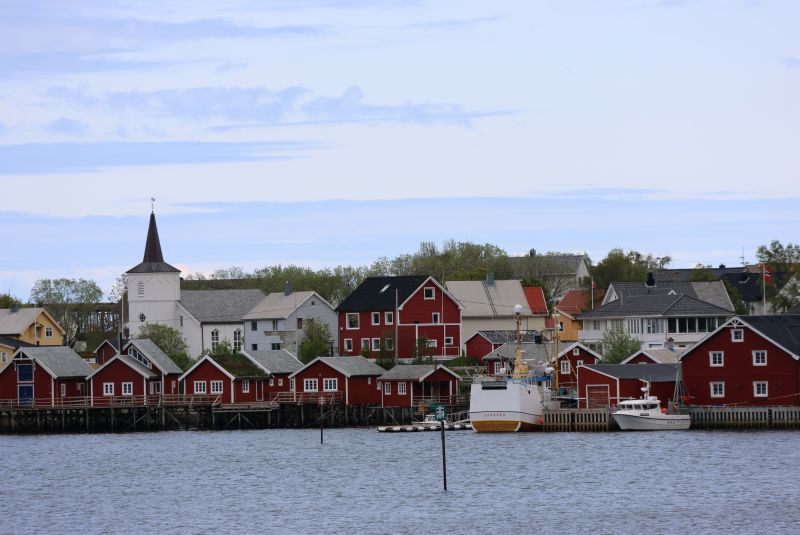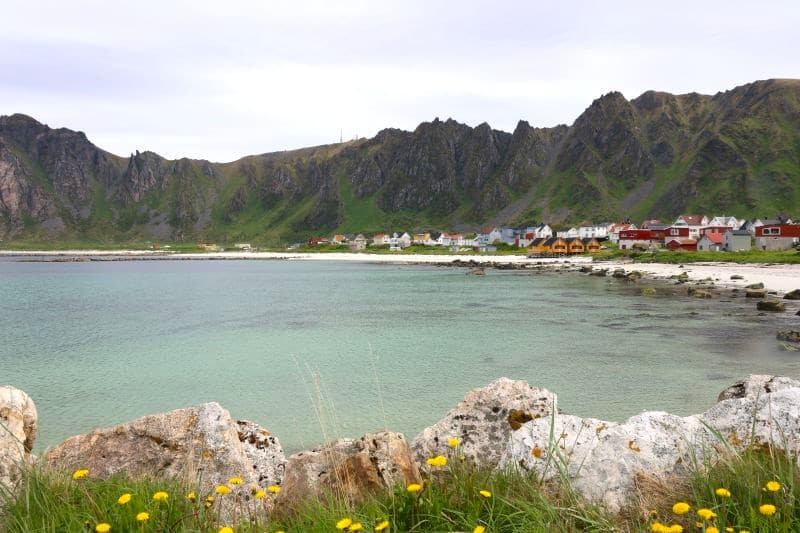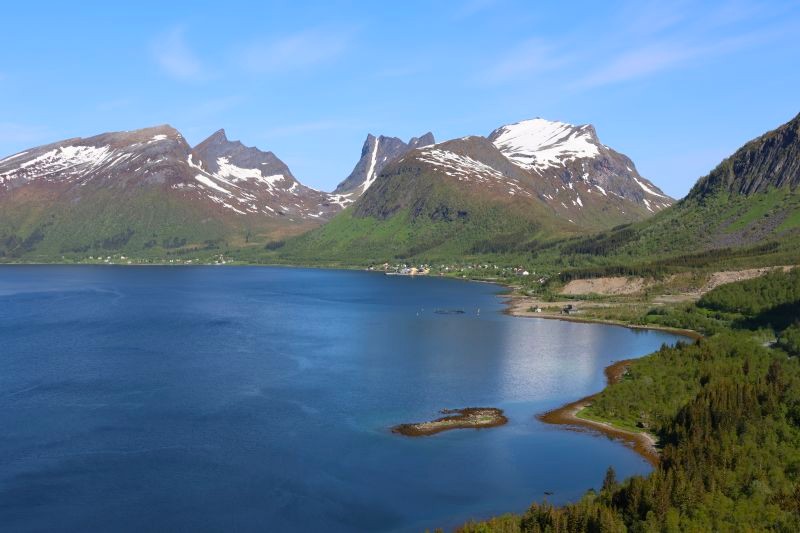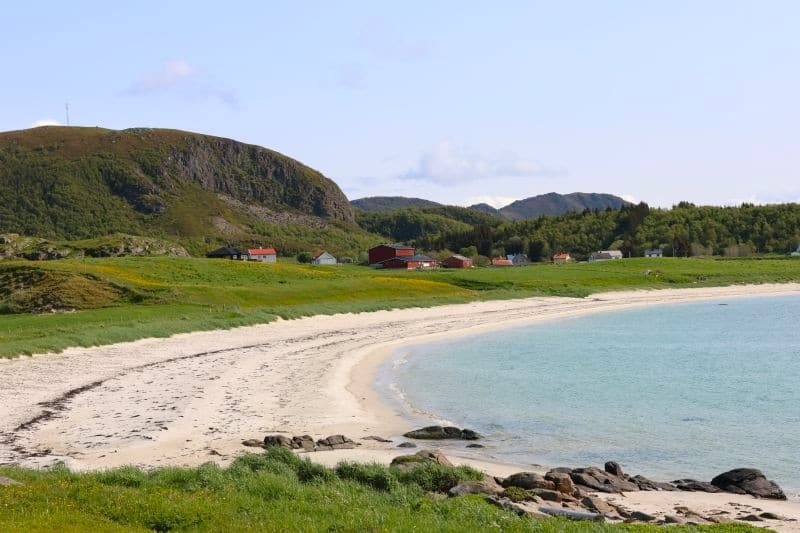Northern Norway Itinerary: Highlights and Travel Tips
Looking for inspiration for your next road trip? This two-week Northern Norway itinerary takes you across the most stunning islands above the Arctic Circle. Discover the dramatic landscapes of the famous Lofoten Islands, the tranquil rhythm of the Vesterålen, and the rugged beauty of Senja. Continue on to the vibrant university city of Tromsø before ending your journey amid fjords and mountains in the Narvik region. In this article, you’ll find not only the full itinerary but also the best highlights and practical tips for an unforgettable journey through Northern Norway.
For this trip, we flew directly from Brussels to Evenes, near Narvik, and began our road trip in the Lofoten Islands. Of course, you can easily drive the route in reverse or start your adventure in Tromsø instead.

Days 1-4: Steep Mountains, White Beaches and Fishing Villages in the Lofoten Islands
There’s no better way to start your Northern Norway itinerary than with a visit to the popular Lofoten Islands. Here, you’ll encounter spectacular landscapes: steep peaks, deep blue fjords, and white sandy beaches. The islands are a hiker’s paradise, and in the many charming fishing villages you can soak up the authentic island life. Here are some highlights you won’t want to miss:
Svolvær
Svolvær, often called the capital of the Lofoten, is the perfect base for exploring the islands. The town has a lively harbour, a good selection of hotels, and several cosy restaurants. From Svolvær, you can take a boat trip to the Trollfjord, a narrow fjord flanked by steep cliffs, where you might spot sea eagles along the way. For a great view over the town, hike Tjeldbergtinden or the iconic rock formation Svolværgeita.
Henningsvær
The photogenic fishing village of Henningsvær is spread across a few small islands, connected by bridges. The narrow road leading there is worth the detour from the E10 on its own. Henningsvær is especially famous for its iconic football pitch, dramatically set between the rocks and the sea. Wander through the colourful streets, visit one of the art galleries, and finish with a bite and a drink at Klatrekafeen, the village’s cosiest café. Here, you can soak up the bohemian atmosphere that makes Henningsvær so beloved.
Haukland Beach
There are plenty of beautiful beaches in the Lofoten Islands, but Haukland Beach might just be the most stunning: white sand, turquoise waters, and steep mountain peaks in the background. On sunny days, it almost feels tropical, although the water remains icy cold. For the best views of both Haukland Beach and the neighbouring Uttakleiv Beach, climb the summit of Mannen, around 400 metres above sea level. The hike starts at the new visitor centre and is manageable for anyone with a reasonable level of fitness.
Nusfjord
Nusfjord is one of Norway’s oldest and best-preserved fishing villages. It has the feel of an open-air museum: a small entrance fee (around 100 NOK) gives you access to the village. In return, you gain a unique insight into island life and the village’s history. You’ll find traditional wooden rorbuer (fishermen’s cabins, some available for overnight stays), along with a few restaurants, an old bakery, and an art gallery. Keep in mind that parking is limited, especially during the high season.
Reine
Reine is one of the most beautiful fishing villages in the Lofoten Islands. The contrast between the colourful wooden rorbuer by the water and the steep mountain peaks, such as the famous Reinebringen, makes the village a popular destination for visitors. Skrei is still traditionally dried here on wooden racks. You’ll also find a few charming shops and cosy cafés, and for an overnight stay, a great choice is Reine Rorbuer.
Accommodation Tip: Stay at the modern and stylish Thon Hotel Svolvær, centrally located by the water. The rooms are spacious and comfortable, and in the morning you can enjoy a generous breakfast buffet. After a day of adventure, relax in the floating sauna or savour local dishes and crispy pizzas in the hotel’s restaurant.

Days 5–7: Wildlife and Culture in Vesterålen
After the busy Lofoten Islands, the Vesterålen archipelago feels like a breath of fresh air. The landscape here is softer and more rolling, but no less impressive. You can go on beautiful hikes, explore fishing villages and get a taste of local culture. It’s also one of the best places in Northern Norway for spotting wildlife.
Puffins, Whales and Moose
The Vesterålen are famous for their rich wildlife, and the island of Andøya in particular is a paradise for nature lovers. From Bleik, you can take a boat trip to the rocky island of Bleiksøya, home to thousands of puffins during the breeding season. For a whale safari head to Andenes. When the weather permits, you’ll head out in a fishing boat or RIB to spot sperm whales and other species. Even on the road, keep your eyes open: you might just spot a moose crossing your path.
Nyksund
The former ghost village of Nyksund is now a vibrant artists’ colony on the island of Langøya. Its once-abandoned wooden houses have been beautifully restored and now host galleries, intimate cafés and unique places to stay. The creative atmosphere and colourful buildings form a striking contrast with the wild nature surrounding the village. From Nyksund, you can also start the popular Dronningruta (Queen’s Route), one of Northern Norway’s most scenic hikes.
Hurtigruten Museum
The Hurtigruten Museum in Stokmarknes tells the story of the legendary coastal express that has been sailing along Norway’s coast since 1893. You’ll learn about the history of this iconic voyage and its impact on remote coastal communities. Part of the museum is housed inside an original ship from the 1950s. You’ll get a real sense of what life on board was like, and can even peek into the engine room and the cabins.
Accommodation Tip: Ringstad Resort in Bø is a hidden gem on the west coast of the Vesterålen. You’ll stay in stylish rooms overlooking the sea and can join guided activities such as mountain hikes, kayaking trips or sea eagle safaris. After a day of adventure, unwind in the outdoor jacuzzi and enjoy the pure flavours of Northern Norway in the cosy restaurant.

Days 8–9: Road-tripping and Hiking on Senja
From the Vesterålen, continue your journey to Senja, without a doubt one of the highlights of any Northern Norway itinerary. Norway’s second-largest island impresses with its diverse landscapes: deep fjords, rugged peaks, winding coastal roads and white sandy beaches. It’s also a paradise for hiking and exploring by car or bike.
Scenic Route Senja
The route along Senja’s west coast is one of Norway’s most beautiful drives. This 102-kilometre stretch connects Botnhamn and Gryllefjord, winding past fjords, beaches and striking architectural viewpoints. Highlights along the way include the 44-metre viewing platform at Bergsbotn and Tungeneset, where a wooden walkway leads over the rocks to the sea. Finally, Ersfjordstranda is a lovely spot for a seaside picnic – or, for the brave, a refreshing dip.
Hiking on Senja
Senja is a dream destination for hiking enthusiasts, with endless trails to choose from. Our favourite? The Hesten hike: a relatively short but steep trail that climbs around 500 metres. At the top, you’re rewarded with a breathtaking view of the iconic Segla peak. Make sure to wear sturdy hiking boots, bring enough water, and don’t forget your camera.
Accommodation Tip: Hamn i Senja, located on the island’s west coast, is the perfect base for exploring Senja’s wild landscapes. You can rent e-bikes, go kayaking, try body rafting or join a fishing trip. Accommodation ranges from spacious suites to compact studios, all simply but comfortably furnished. At Storbrygga Spiseri, you can enjoy breakfast, lunch or dinner with a beautiful view over the water.

Days 10–11: Tromsø, the Arctic Capital
After the pristine nature of Senja, it’s time for a taste of city life in Tromsø, the largest city in Northern Norway. This lively university town is beautifully surrounded by fjords and mountains. You can visit fascinating museums, go shopping, or sample the refined flavours of Arctic cuisine.
Arctic Cathedral
From the city centre, walk across the Tromsø Bridge to the Tromsdalen district, where the Arctic Cathedral immediately catches the eye. This striking church, which opened in 1965, resembles a giant iceberg with its bold design. Step inside to admire the impressive stained-glass window. The cathedral also hosts regular midnight sun and northern lights concerts.
Museums in Tromsø
The Polar Museum is housed in a former customs warehouse and tells the story of the explorers and fur traders who ventured into the Arctic. At the Perspektivet Museum you can delve deeper into the city’s history and discover local artists such as Cora Sandel. The museum also hosts regular photography exhibitions featuring both Norwegian and international photographers.
Polaria
Polaria is an Arctic experience centre where interactive exhibitions and educational panoramic films help you learn more about the polar regions. In the aquarium, you can discover the rich underwater life, while the feeding sessions offer a close-up view of the playful seals.
Flavours of the North
A night out to enjoy the local cuisine is a must during your stay in Tromsø. At Arctandria you can sample refined Arctic dishes, with fish and seafood taking centre stage. The house specialties, lutefisk and boknafisk, are traditional cod dishes typical of Northern Norway. Fancy pizza instead? Then Casa Inferno is the place to go. Brasserie Mack is known as the world’s northernmost brewery, and in the cosy 1928 pub you can sample a variety of local beers.
Accommodation Tip: Clarion Hotel The Edge is a large, contemporary hotel, centrally located by Tromsø’s harbour. You stay in modern rooms equipped with every comfort. Each morning, a generous and meticulously prepared breakfast buffet awaits you. To top it all off, the 11th floor features a sky bar with a rooftop terrace offering stunning views over the city.

Days 12–14: Narvik Region: History and Nature
After lively Tromsø, the area around Narvik provides a fitting finale to your North Norway itinerary. Here, history and nature come together: from war museums to stunning fjords and snow-capped mountains. Whether you prefer hiking or exploring the region by train, Narvik has something for everyone.
Polar Park
About an hour’s drive from Narvik lies Polar Park, the world’s northernmost wildlife park. Wolves, moose, bears, lynx, reindeer, and musk oxen roam in a setting that closely resembles their natural habitat. Allow plenty of time for your visit, as patience increases your chances of seeing the animals up close.
Arctic Train
A spectacular train journey along fjords, waterfalls, and mountain scenery takes you from Narvik to the Swedish border. The Arctic Train follows the historic Ofotbanen line. Along the way, you’ll learn more about the history of this railway, which played an important role during the Second World War. The views are breathtaking, so be sure to book your ticket in advance for this popular trip.
Hiking Around Narvik
Hiking enthusiasts will also find plenty to enjoy in this region. From the town centre, the cable car takes you up to Narvikfjellet, where several trails start with panoramic views over the Ofotfjord. We, however, opted for the Reinneset hike, around a 40-minute drive from Narvik. This short walk takes you over bare granite rocks to the summit, where you are rewarded with breathtaking views of the Skjomenfjord and the Reintindbreen glacier.
Accommodation Tip: Quality Hotel Grand Royal is located in the heart of Narvik, combining classic charm with modern comfort. Some rooms are slightly outdated, but the hotel is currently undergoing renovations. In the cosy Rallar’n Pub & Kro, you can enjoy traditional Norwegian dishes in an informal setting, while Linken Restaurant & Bar on the roof serves refined tapas, creative cocktails, and stunning views of the fjord and surrounding mountains.

FAQ – Practical Tips for Your Northern Norway Itinerary
We travelled with Nordic to the far north. This tour operator offers a direct flight from Brussels to Evenes, and also arranges all accommodation and a rental car with full insurance, so you can explore without any worries. Of course, you can also book your flights, accommodation and car independently. Just be sure to read our practical tips first to travel well-prepared in Northern Norway.
What Is the Best Time to Visit Northern Norway?
From late May to mid-July, you can enjoy the midnight sun in Northern Norway. It stays light day and night, ideal for those who want to make the most of their trip. July and August can be busier, especially in the Lofoten Islands, and prices are usually higher. September is a good month for those who love autumn colours and a quieter pace. The days are shorter, and you may already get a chance to see the Northern Lights. If you prefer to travel in winter, keep in mind snowy roads and shorter days, but also a magical white landscape.
How Do You Travel to Northern Norway?
For this Northern Norway itinerary, it’s best to fly to Evenes (near Narvik) or Tromsø. If possible, choose a direct flight: sustainable and convenient. If that’s not an option, connecting via Oslo is easy. For travellers with more time, the trip can be extended with a a road trip through Southern Norway or a visit to Sweden. In that case, you travel by car or ferry to the north.
How Do You Get Around Northern Norway?
The region is best explored by rental car, ideally booked in advance. Sunny Cars includes all insurance in the rental price. Tolls and ferry fees are also automatically covered. Between the Lofoten and Vesterålen, take the ferry from Fiskebøl to Melbu – a 25-minute crossing with multiple daily departures. In summer, it’s wise to arrive at least 30 minutes early. Between Vesterålen and Senja, you can take the ferry from Andenes to Gryllefjord, but since crossings are limited, the longer overland route is often a more reliable option.
What Clothing Should You Pack?
The weather in Northern Norway can change quickly, even in summer. Layers are essential: thermal underwear, a warm jumper, and a wind- and waterproof jacket. Sturdy walking shoes are a must, along with a scarf or buff, hat, and gloves. Don’t forget sunglasses and sunscreen, as the sun can be strong. You might also pack swimwear for a sauna, hot tub, or a refreshing dip.
How Much Does a Trip to Northern Norway Cost?
Northern Norway is not a cheap destination. Eating out can be expensive, especially if you enjoy wine or beer. Booking in advance can save you a lot. Alternatively, choose accommodation with a kitchen so you can cook some meals yourself. Supermarkets such as Kiwi and Rema 1000 are usually the most affordable. The region’s biggest asset – the breathtaking nature – is free of charge. With some planning and smart choices, you don’t need a fortune to fully enjoy the north.



This article contains some affiliate links. This means we receive a small commission if you book or purchase through our recommendations. It doesn’t cost you anything extra, but it does help support this blog. Thank you for helping Into the North continue to grow!